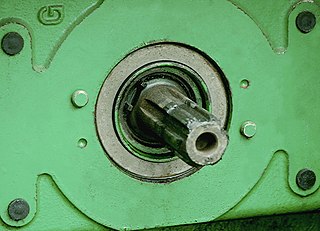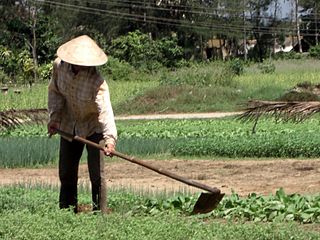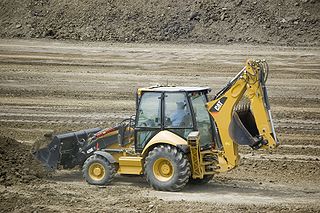
A plough or (US) plow is a farm tool for loosening or turning the soil before sowing seed or planting. Ploughs were traditionally drawn by oxen and horses but modern ploughs are drawn by tractors. A plough may have a wooden, iron or steel frame with a blade attached to cut and loosen the soil. It has been fundamental to farming for most of history. The earliest ploughs had no wheels; such a plough was known to the Romans as an aratrum. Celtic peoples first came to use wheeled ploughs in the Roman era.

A tractor is an engineering vehicle specifically designed to deliver a high tractive effort at slow speeds, for the purposes of hauling a trailer or machinery such as that used in agriculture, mining or construction. Most commonly, the term is used to describe a farm vehicle that provides the power and traction to mechanize agricultural tasks, especially tillage, and now many more. Agricultural implements may be towed behind or mounted on the tractor, and the tractor may also provide a source of power if the implement is mechanised.

In agriculture, a harrow is a farm implement used for surface tillage. It is used after ploughing for breaking up and smoothing out the surface of the soil. The purpose of harrowing is to break up clods and to provide a soil structure, called tilth, that is suitable for planting seeds. Coarser harrowing may also be used to remove weeds and to cover seed after sowing.

The modern combine harvester, also called a combine, is a machine designed to harvest a variety of cultivated seeds. Combine harvesters are one of the most economically important labour-saving inventions, significantly reducing the fraction of the population engaged in agriculture. Among the crops harvested with a combine are wheat, rice, oats, rye, barley, corn (maize), sorghum, millet, soybeans, flax (linseed), sunflowers and rapeseed. The separated straw is then either chopped onto the field and ploughed back in, or laid out in rows, ready to be baled and used for bedding and cattle feed.

A power take-off or power takeoff (PTO) is one of several methods for taking power from a power source, such as a running engine, and transmitting it to an application such as an attached implement or separate machine.

A hoe is an ancient and versatile agricultural and horticultural hand tool used to shape soil, remove weeds, clear soil, and harvest root crops. Shaping the soil includes piling soil around the base of plants (hilling), digging narrow furrows (drills) and shallow trenches for planting seeds or bulbs. Weeding with a hoe includes agitating the surface of the soil or cutting foliage from roots, and clearing the soil of old roots and crop residues. Hoes for digging and moving soil are used to harvest root crops such as potatoes.

A loader is a heavy equipment machine used in construction to move or load materials such as soil, rock, sand, demolition debris, etc. into or onto another type of machinery.

A backhoe loader, also called a loader backhoe, loader excavator, tractor excavator, digger or colloquially shortened to backhoe within the industry, is a heavy equipment vehicle that consists of a tractor-like unit fitted with a loader-style shovel/bucket on the front and a backhoe on the back. Due to its (relatively) small size and versatility, backhoe loaders are very common in urban engineering and small construction projects as well as developing countries. This type of machine is similar to and derived from what is now known as a TLB (Tractor-Loader-Backhoe), which is to say, an agricultural tractor fitted with a front loader and rear backhoe attachment.

A mower is a person or machine that cuts (mows) grass or other plants that grow on the ground. Usually mowing is distinguished from reaping, which uses similar implements, but is the traditional term for harvesting grain crops, e.g. with reapers and combines.

A forage harvester – also known as a silage harvester, forager or chopper – is a farm implement that harvests forage plants to make silage. Silage is grass, corn or hay, which has been chopped into small pieces, and compacted together in a storage silo, silage bunker, or in silage bags. It is then fermented to provide feed for livestock. Haylage is a similar process to silage but using grass which has dried.

A cultivator is a piece of agricultural equipment used for secondary tillage. One sense of the name refers to frames with teeth that pierce the soil as they are dragged through it linearly. Another sense of the name also refers to machines that use the rotary motion of disks or teeth to accomplish a similar result, such as a rotary tiller.

The Ford N-series tractors were a line of farm tractors produced by the Ford Motor Company between 1939 and 1952, spanning the 9N, 2N, and 8N models.
New Holland is a global full-line agricultural machinery manufacturer founded in New Holland, Pennsylvania, and now based in Turin, Italy. New Holland's products include tractors, combine harvesters, balers, forage harvesters, self-propelled sprayers, haying tools, seeding equipment, hobby tractors, utility vehicles and implements, and grape harvesters. Originally formed as the New Holland Machine Company in 1895, the company is now owned by CNH Industrial N. V., a company incorporated in the Netherlands.

A trencher is a piece of construction equipment used to dig trenches, especially for laying pipes or electrical cables, for installing drainage, or in preparation for trench warfare. Trenchers may range in size from walk-behind models, to attachments for a skid loader or tractor, to very heavy tracked heavy equipment.
Landfill mining and reclamation (LFMR) is a process which excavates and processes solid wastes which have previously been landfilled. The process aims to reduce the amount of landfill mass encapsulated within the closed landfill and/or temporarily remove hazardous material to allow protective measures to be taken before the landfill mass is replaced. In the process, mining recovers valuable recyclable materials, a combustible fraction, soil, and landfill space. The aeration of the landfill soil is a secondary benefit with regard to the landfill's future use. The combustible fraction is useful for power generation. The overall appearance of the landfill mining procedure is a sequence of processing machines laid out in a functional conveyor system. The operating principle is to excavate, sieve and sort the landfill material.

A conditioner is a farm implement that crimps and crushes newly cut hay to promote faster and more even drying. Drying the hay efficiently is most important for first cutting of the hay crop, which consists of coarse stalks that take a longer period of time to draw out moisture than finer-textured hays, such as second and subsequent cuttings.

A bush hog or "brush hog" is a type of rotary mower. Typically these mowers are designed to be towed behind a farm tractor using the three-point hitch and are driven via the power take-off (PTO). It has blades that are not rigidly attached to the drive like a lawnmower blade, but are on hinges so if the blade hits a rock or stump, it bounces backward and inward, and then centrifugal force makes it go outwards again.
Potato harvesters are machines that harvest potatoes. They work by lifting the potatoes from the bed using a share. Soil and crop are transferred onto a series of webs where the loose soil is sieved out. The potatoes are moved towards the back of the harvester on to a separation unit and then to a picking table where people pick out the stones, clods, and haulms by hand. The potatoes then go on to a side elevator and into a trailer or a potato box.
This glossary of agriculture is a list of definitions of terms and concepts used in agriculture, its sub-disciplines, and related fields, including horticulture, animal husbandry, agribusiness, and agricultural policy. For other glossaries relevant to agricultural science, see Glossary of biology, Glossary of ecology, Glossary of environmental science, and Glossary of botanical terms.















